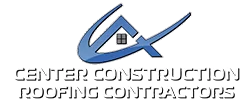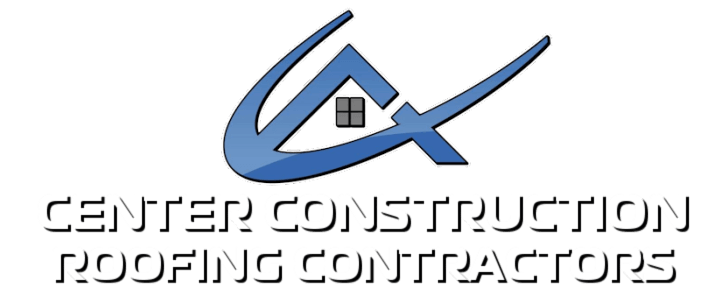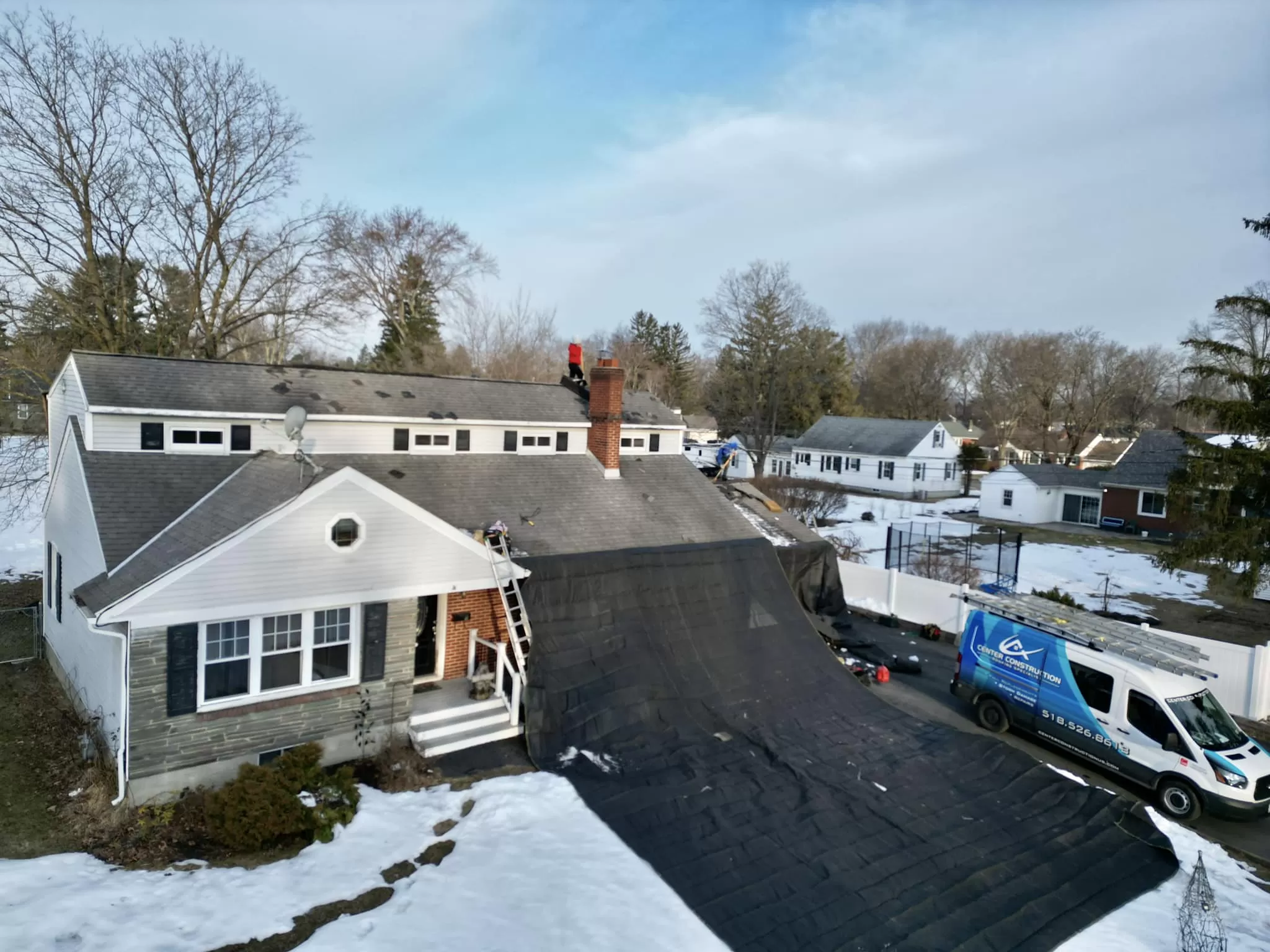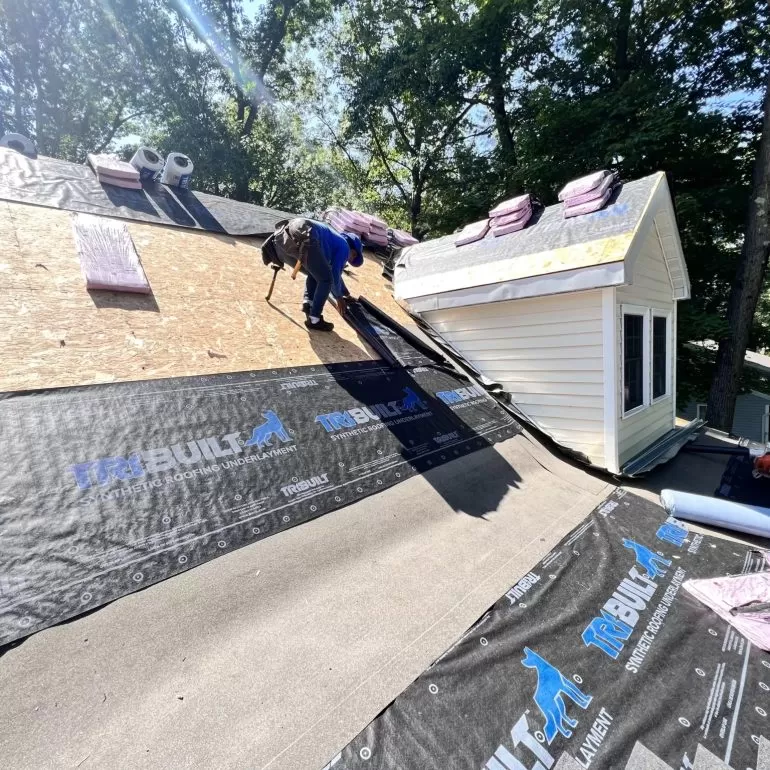When winter blankets Albany with snow and temperatures plummet, many homeowners notice picturesque icicles hanging from their rooflines. While these frozen formations might look enchanting, they often signal underlying problems that could lead to costly damage. Understanding whether icicles on your roof are bad requires looking beyond their aesthetic appeal to the real issues they represent.
Key Points You’ll Learn:
- Why icicles form and what they indicate about your roof’s health
- The connection between icicles and dangerous ice dams
- Preventive measures to protect your home
- When to seek professional roofing assistance
Icicles themselves aren’t inherently damaging, but they’re frequently symptoms of heat loss, poor insulation, and inadequate ventilation—conditions that create ice dams. These ice barriers trap melting snow on your roof, leading to water infiltration, structural damage, and expensive repairs. If you’re noticing frequent or large icicle formations, consulting with experienced professionals like Center Construction LLC can help identify the root cause. Serving Albany, NY, and surrounding areas, their expert team specializes in roofing services, siding, and gutters to keep your home protected throughout harsh winters.
What Causes Icicles to Form on Your Roof?
Icicles develop when snow on your roof melts and refreezes at the edges. This cycle typically happens because:
- Heat escaping from your attic warms the roof surface, melting snow even when outdoor temperatures remain below freezing
- Inadequate insulation allows warmth from living spaces to reach the roof deck
- Poor ventilation prevents cold air circulation that would keep the entire roof at a uniform temperature
- Sun exposure on south-facing slopes creates daytime melting that refreezes overnight
When heated air escapes through your roof, it creates an uneven temperature distribution. The center of your roof becomes warm enough to melt snow, while the eaves—extending beyond your home’s heated envelope—remain cold. Water running down encounters these frigid edges and freezes, forming icicles.
🔍 Expert Tip: The Two-Degree Test
Your roof surface should be within 2 degrees of the outside temperature. If there’s a significant difference, you’re losing heat through your roof. This simple principle helps professionals diagnose insulation and ventilation issues that lead to ice dam formation and persistent icicle problems.
The Ice Dam Connection: Why Icicles Signal Trouble
While a few small icicles might seem harmless, they often indicate ice dam development—a serious winter roofing hazard. Ice dams form when repeated freeze-thaw cycles create thick ice ridges along roof edges, preventing proper drainage.
The damage progression includes:
- Water backing up under shingles and penetrating roof decking
- Interior ceiling and wall stains from water infiltration
- Insulation saturation reducing energy efficiency
- Potential mold growth in attic spaces
- Gutter damage from excessive ice weight
Understanding residential roofing services helps homeowners recognize when professional intervention becomes necessary. Regular maintenance and proper installation techniques significantly reduce ice dam risks.
| Warning Sign | What It Indicates | Action Required |
|---|---|---|
| Small, occasional icicles | Minor heat loss or sun exposure | Monitor and improve attic insulation |
| Large, frequent icicles | Significant heat escape and ventilation issues | Professional inspection needed |
| Icicles with interior leaks | Active ice dam causing water damage | Immediate professional intervention |
| Sagging gutters with ice | Excessive weight and drainage problems | Gutter assessment and potential replacement |
Prevention Strategies: Protecting Your Albany Home
Preventing icicle formation requires addressing the underlying causes rather than simply removing the ice. Here are proven strategies:
Improve Attic Insulation: Adding adequate insulation (R-49 to R-60 for Albany’s climate) keeps heat inside living spaces where it belongs. This reduces roof surface warming and minimizes snow melting.
Enhance Ventilation: Proper soffit and ridge vents create continuous airflow, maintaining uniform roof temperatures. Cold air enters through soffit vents and exits through ridge vents, preventing warm spots.
Seal Air Leaks: Gaps around chimneys, recessed lights, attic hatches, and plumbing vents allow warm air to escape. Professional air sealing eliminates these pathways.
Maintain Clean Gutters: Clogged gutters prevent proper drainage, contributing to ice accumulation. Regular cleaning before winter prevents backup issues.
For comprehensive protection, consider scheduling a roofing inspection before winter arrives. Professional assessments identify vulnerabilities before they become expensive problems.
When Icicles Indicate Roof Damage
Sometimes, are icicles on your roof bad enough to require immediate attention? Certain situations demand professional evaluation:
- Visible sagging in gutters or roof edges from ice weight
- Water stains appearing on interior ceilings or walls
- Unusual ice patterns suggesting localized heat sources
- Damaged or missing shingles discovered during visual inspection
Commercial properties face similar challenges with often more complex roof systems. Commercial roofing solutions address larger-scale ice management issues specific to business buildings.
⚠️ Safety Warning
Never attempt to remove large icicles or ice dams yourself. The risks include:
- Falling from ladders or slippery roofs
- Icicles falling and causing injury
- Damaging roof materials with improper tools
- Creating additional water infiltration problems
Always contact experienced professionals for safe ice removal and damage prevention.
Long-Term Solutions and Roof Health
Addressing chronic icicle problems might require more comprehensive solutions. Older roofs with repeated ice damage may benefit from roofing replacement services that incorporate modern ice and water barriers, improved ventilation designs, and enhanced materials.
For homes experiencing recurring issues, systematic approaches work best. This includes evaluating insulation R-values, assessing ventilation adequacy, examining roof pitch and drainage, and considering architectural modifications if necessary. Minor damages caught early often need only residential roofing repair rather than complete replacement.
Frequently Asked Questions
Q: Do all icicles mean I have a problem with my roof?
A: Not necessarily. A few small icicles from occasional sun exposure are normal. However, large, numerous, or persistent icicles typically indicate heat loss and inadequate insulation—issues that can lead to ice dams and water damage.
Q: Can I prevent icicles without replacing my roof?
A: Yes, most icicle problems stem from insulation and ventilation issues rather than the roof itself. Improving attic insulation, enhancing ventilation, and sealing air leaks often resolves the problem without roof replacement.
Q: When should I call a professional about roof icicles?
A: Contact a roofing professional if you notice large icicle formations, interior water stains, sagging gutters, patterns suggesting ice dams, or if icicles return quickly after removal. Early intervention prevents costly damage.
Q: How much does it cost to fix icicle-related roof problems?
A: Costs vary depending on the underlying cause. Simple insulation improvements might cost less than addressing structural ice dam damage. A professional inspection helps determine the specific issues and appropriate solutions for your situation.
Protect Your Albany Home This Winter
Don’t let icicles become ice dams. Center Construction LLC provides comprehensive roofing inspections, repairs, and preventive solutions to keep your home safe and dry throughout winter. Our experienced team serves Albany, NY, and surrounding areas with professional roofing services, siding, and gutter solutions.
Early detection saves thousands in repair costs. Let our experts assess your roof’s condition and recommend the best solutions for your situation.






